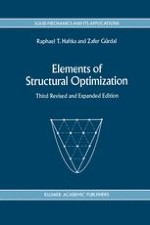1992 | OriginalPaper | Chapter
Unconstrained Optimization
Authors : Raphael T. Haftka, Zafer Gürdal
Published in: Elements of Structural Optimization
Publisher: Springer Netherlands
Included in: Professional Book Archive
Activate our intelligent search to find suitable subject content or patents.
Select sections of text to find matching patents with Artificial Intelligence. powered by
Select sections of text to find additional relevant content using AI-assisted search. powered by
In this chapter we study mathematical programming techniques that are commonly used to extremize nonlinear functions of single and multiple (n) design variables subject to no constraints. Although most structural optimization problems involve constraints that bound the design space, study of the methods of unconstrained optimization is important for several reasons. First of all, if the design is at a stage where no constraints are active then the process of determining a search direction and travel distance for minimizing the objective function involves an unconstrained function minimization algorithm. Of course in such a case one has constantly to watch for constraint violations during the move in design space. Secondly, a constrained optimization problem can be cast as an unconstrained minimization problem even if the constraints are active. The penalty function and multiplier methods discussed in Chapter 5 are examples of such indirect methods that transform the constrained minimization problem into an equivalent unconstrained problem. Finally, unconstrained minimization strategies are becoming increasingly popular as techniques suitable for linear and nonlinear structural analysis problems (see Kamat and Hayduk[[1]])which involve solution of a system of linear or nonlinear equations. The solution of such systems may be posed as finding the minimum of the potential energy of the system or the minimum of the residuals of the equations in a least squared sense.
